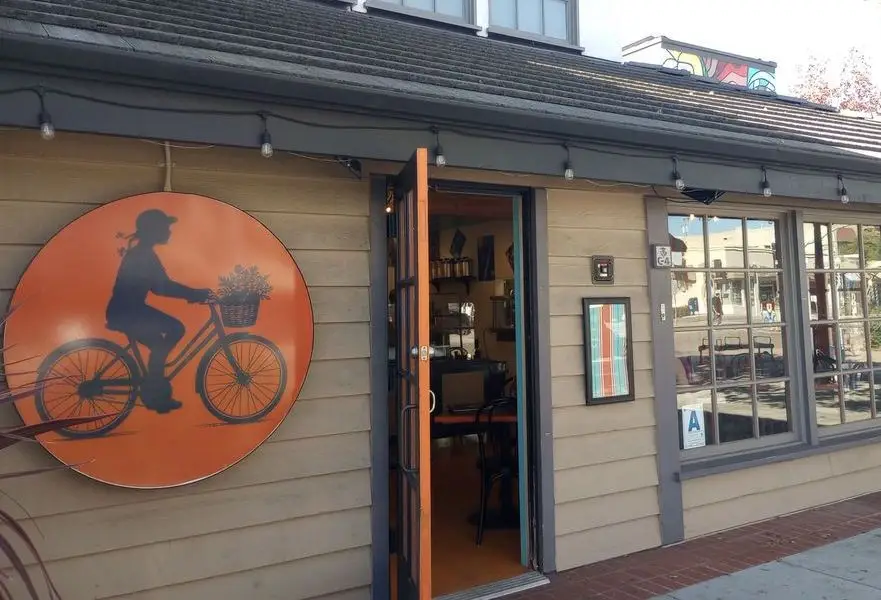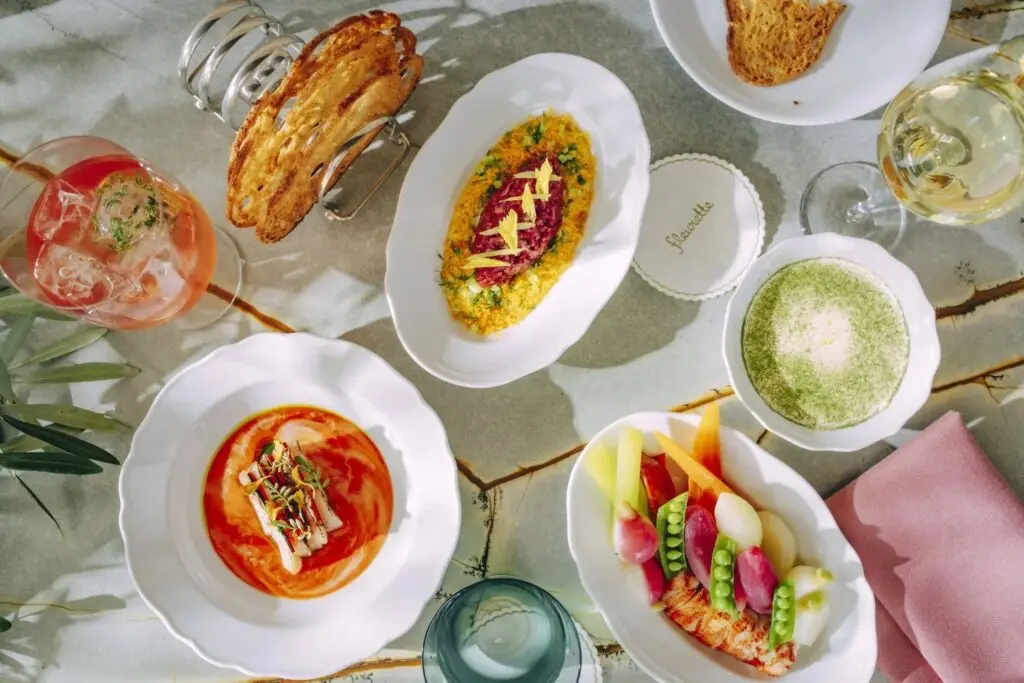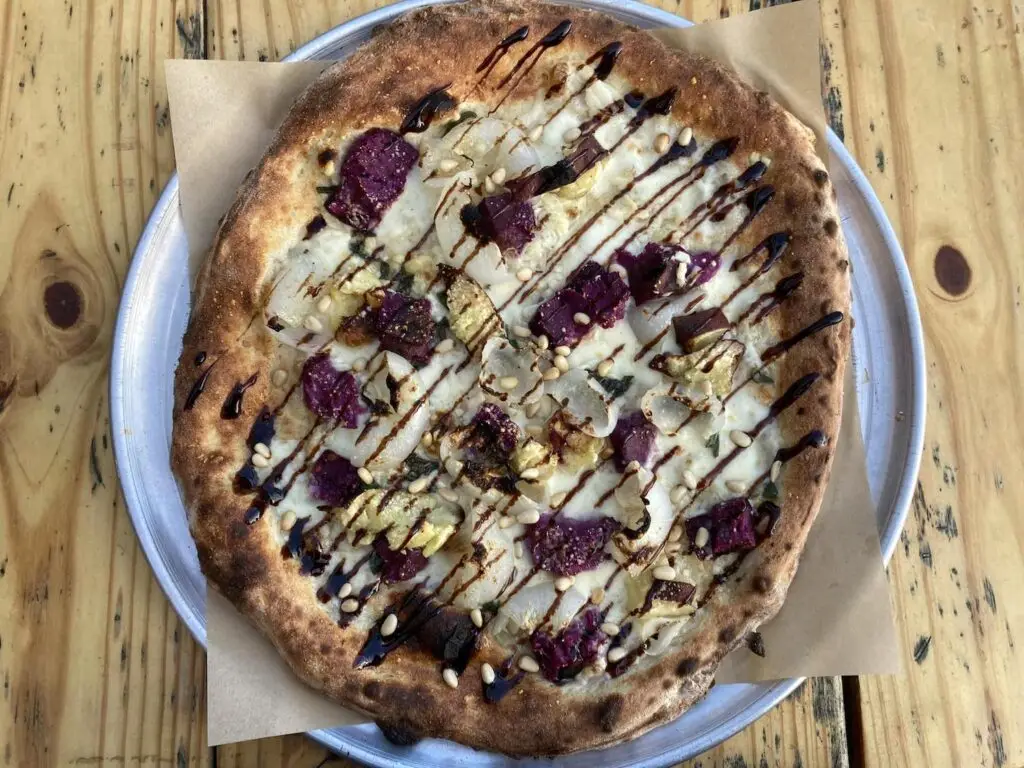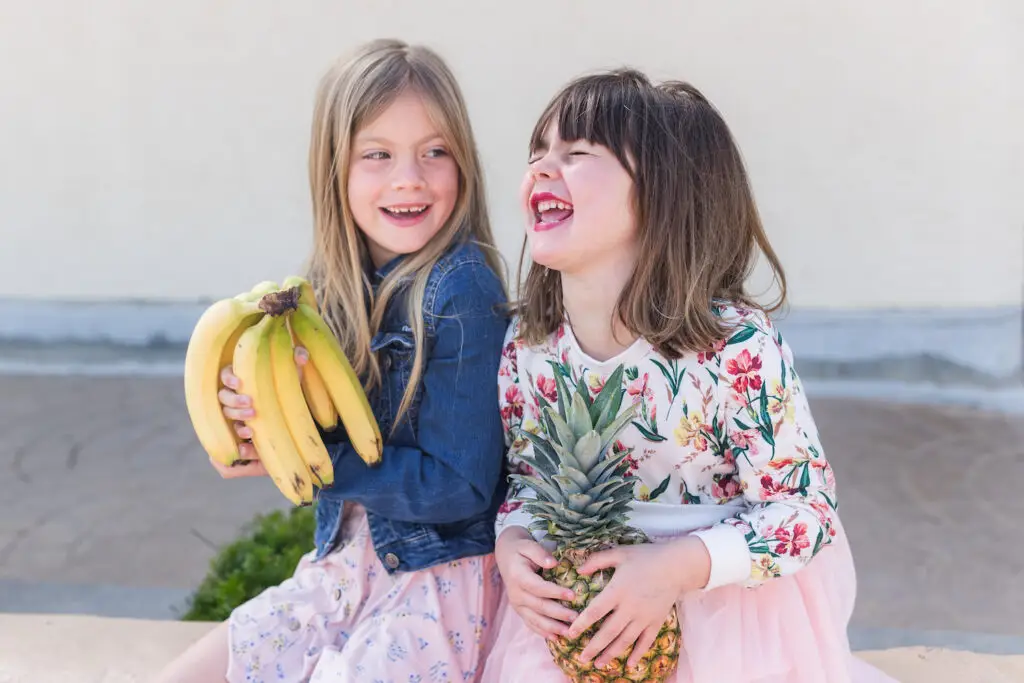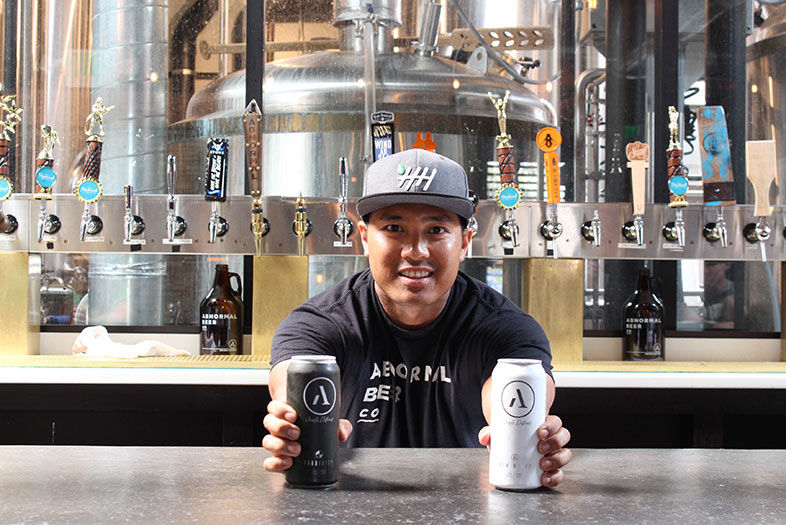We’re fortunate in San Diego to have lots of folks thinking about great ways to put beer and food together. Our craft beer boom has inspired chefs all over the county to think about beer as a culinary ingredient and to conceive of cool and interesting ways to pair foods with craft brews. This environment has also inspired brewers to have conversations with chefs and to think about creating beers that work especially well with food.
Derek Gallanosa, head brewer for Abnormal Beer Co., happily sits right in the center of his own unique little beer/food/wine/restaurant nexus. Because Abnormal Beer Co. is housed in the same facility as the Cork & Craft restaurant and Abnormal Wine Co. in Rancho Bernardo, Derek is afforded the opportunity to use a wealth of culinary-based resources in his brewing program—and that’s a very good thing. It’s evident, when talking to him, that Derek loves to think about the beers he makes in the same way a chef thinks about a recipe. And he’s most excited when a beer and a dish interact in a way that makes them both change—evolve, even—in a magical and delicious way.
With a crisp and refreshing pint of Amassed Hoppy Belgian Blonde in hand (a Hallertau Blanc dry-hopped ale done in collaboration with Cosimo Sorrentino), I chatted with Derek about the beauty of brewing collaborations, where he comes down in the hazy beer debate, and why he loves having a brewery inside a fine dining restaurant.
Well, you just finished Abnormal’s first canning run ever. How does that feel?
It feels great, because we get to showcase our beer to even more people. And, instead of going to bars around town and having to guess where it is, people can come here and they know they can get it to go. So it’s exciting that we’ll see a lot more people having access to it.
You started with a very limited canning run of Turbidity IIPA and New Money Hazy IPA. Will you eventually have enough cans so you can have them available all the time?
Definitely. Down the road, I want to have runs to send out to retail. The retail ones will probably be more of our Boss Pour IPA, just because it will last a bit longer. The hazy stuff you want to get out right away. Once we’re able to can more, have more cold storage, and more labor in the brewery, we’ll be able to bust out more packaged IPAs and other beers in general.
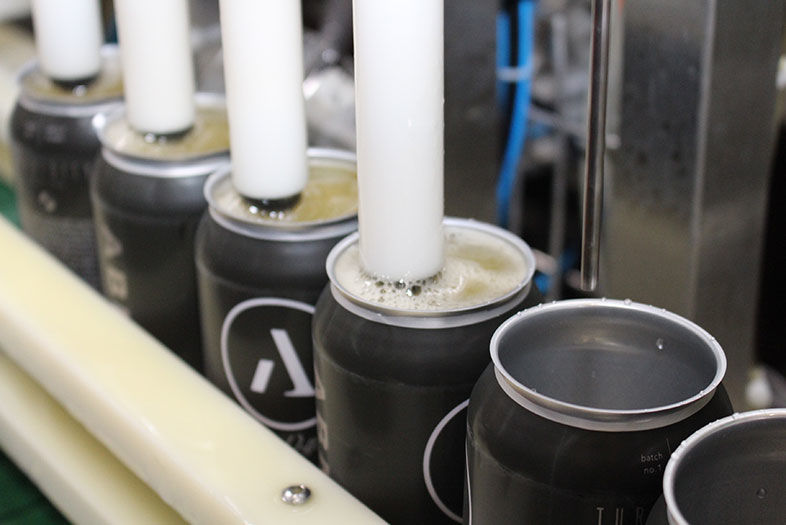
Have a Beer with Abnormal Brewer Derek Gallanosa
The very first cans of Turbidity IIPA make their way down the canning line. | Photo: Bruce Glassman
The very first cans of Turbidity IIPA make their way down the canning line. | Photo: Bruce Glassman
Why did you decide to can these two beers as your first two?
Hazy beers are kind of the hot trend, and there’s a lot of demand, so we knew we’d be able to sell it right away. And we wanted to do beers where we could do an event. We wanted to hold it at a time when we’re not normally open for business—Saturday morning—and just wanted to showcase our first canning. We knew this was something that would draw attention and draw a crowd.
The hazy beer craze has really polarized a lot of folks in the brewing community. You either hate it or love it. So where do you come down in the debate?
Well, we make the West Coast style IPAs and we also make the hazy-style IPAs, but they’re completely different. The hazy beers have a different mash temperature, different grain bills (higher protein content than standard IPAs), different fermentation temperature, different dry-hopping method (we dry hop during fermentation), and different yeast. So basically, every variable across the board is a little bit different. I mean, I probably like the West Coast style more, but I also really enjoy the hazy style IPAs, that’s why I choose to make both. The hazy style is interesting. It’s a new style where people are still developing an understanding of how to make it, so that’s why it’s fun to create and to kind of develop our own technique.
What do you say to the traditionalists who say, “Beer should be clear. That’s why I don’t like hazy IPAs.”
There are a lot of styles that aren’t clear, that are yeast-forward beers. But this is a new style and, to me, it is beer. It’s not a gimmick and it’s done with a lot of effort and precision, just like everything else. It’s definitely not “lazy brewing”; it takes just as long to ferment and everything. It has a different mouthfeel, aroma, and flavor to it, which are not necessarily better or worse, just different. And that’s why it deserves its own category, in my opinion. I think, down the road, you’ll start to see more style guidelines for it. It will be fun to see how this style is going to develop and how it’s going to be recognized by the BJCP (Beer Judge Certification Program) and the Brewers Association, because at this point it’s inevitable.
Are there other fermentation techniques and styles you’re looking to play with in the future?
Oh, yeah! Lagers and mixed fermentation. I would love to do mixed fermentation now, but we’re in a winery and that bacteria and wild yeast are wine-killers, so I’m not allowed to play with those. Down the road, as we upgrade our water system, I’d love to do lagers. I take a lot of pride in the fact that I develop a water recipe for each beer that we make. Water is one of the four ingredients, and probably the most important. Right now, our water system isn’t able to produce the kind of water I need for lagers fast enough (reverse osmosis is required) so I don’t feel I can make, say a pilsner, of the quality that I’d like to right now. The mineral quality of the water used in a lager is more important than other beers. You notice the imperfections in the water quality a lot more in lagers, and that’s why—for those beers— I want all reverse osmosis water.
You mentioned working side by side in a winery. You’re the only brewery in town that works in a winery, right?
Definitely. The only winery/restaurant/brewery in San Diego.
So what are some of the unique aspects of sharing your brewery with a winery and restaurant?
Being with a fine dining restaurant and also a winery, it brings in other people that may not necessarily be beer enthusiasts. That means we’re able to expose our brand and what we do in the brewery to those people who otherwise wouldn’t come into just a straight brewery.
Do you find there are certain types of beers that wine lovers like as sort of their “crossover” beers?
Fruited beers and Belgian-styles. Beers with more esters. But it’s really even more about the fine dining drinkers that we see, they’re consumers who are a little bit more into flavor profiles. That’s really my definition of Abnormal Beer Company: it’s taking that palate—that interest in what they’re eating and experiencing—and bringing it over to the brewery where we can create all these different layers of flavors in the beer. It’s also to showcase the complexity that beer can achieve and have it be equal to what wine can achieve.
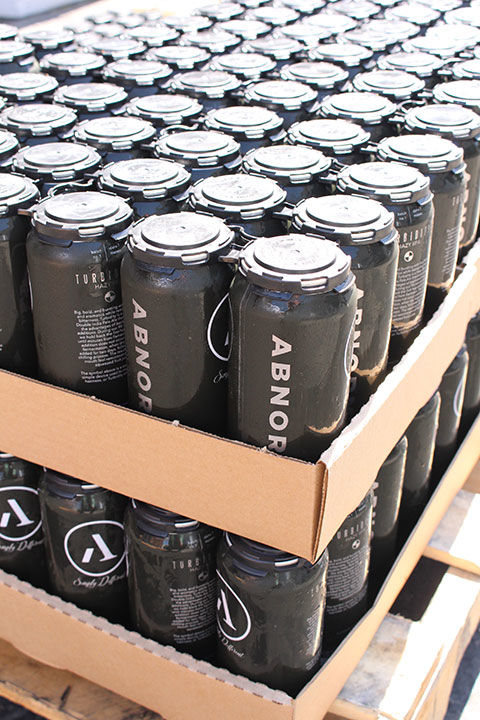
Have a Beer with Abnormal Brewer Derek Gallanosa
Abnormal’s initial canning run was just over 5,000. | Photo: Bruce Glassman
That’s a good segue to talk a little bit about your beer dinner program. How does that program affect the way you think about the beers you brew? You do a lot of collaborating, for one thing.
Take the beer you’re drinking, the Amassed Belgian-style that I did with Cosimo for a beer dinner at Ironside on India Street. We were both involved in the pairing of the beer with the dishes and we wanted to develop a beer for the chefs, so we asked them what they wanted. They asked for something that wouldn’t limit their creative ideas, so we chose a lighter beer that was layered with flavors from Hallertau Blanc hops from Germany. It also has a lot of white wine characteristics as well as the Belgian yeast character. We felt that would pair better with a broader spectrum of food than would, say, an Imperial Stout, which is a lot more complex, robust, and assertive. That’s just one example of how the food can affect what’s being produced in the brewery.
Do you have a constant dialogue with the chefs here? Do you talk about flavors?
All the time. My office is in the corner of the brewery and Scott’s [Cannon, head chef ] office is the kitchen, but we’re in each other’s offices every day. And during different stages of the fermentation process, as well as the finishing process, any product that I feel would work well in the kitchen, I take over a sample and take over some ingredients and show him what’s going on in the brewery. Maybe that will spark an idea for a new dish for him. We make new dishes every week, we do a Farmers Market Friday, and a bonus would be to pair up a new dish with something new that comes out of the brewery. So there’s a constant dialogue with what’s going on in the kitchen.
Any collaborations coming up that you’re particularly excited about?
The only two coming up that are scheduled so far are with The Bruery, which will be in a few months, and then in August we’ll do another with Masumoto Family Farms that features their fruit. We’ll have a lot of peach and nectarine sours coming from breweries across California with that one.
You have some barrel aging going on as well, yes?
That will be our next bottle release. When we first opened, we had an opportunity to purchase some 20-year-old Pappy Van Winkle [bourbon] barrels, so we immediately had to make a beer for them, which was an Imperial Stout. Right now it’s been in the barrels for two years, we’ve tasted it along the aging process, and it wasn’t ready until now. All the barrels tasted different, but they all tasted very good. So, for three of them we’re going to do single-barrel bottles, and with the fourth barrel we’re going to blend down a little bit and treat it with Mostra’s Jamaican Blue Mountain coffee, cacao nibs from Ghana, and Tahitian vanilla beans. We’ll do that bottle release hopefully within a couple of months.
Collaborations seem to be something that keep you excited about brewing. You’ve done a whole lot of collaborations with other breweries, including Alpine, Monkey Paw, Cellar 3, and Stone.
Yeah, definitely. I have collaborations coming out soon with The Bruery and also Great Notion out of Portland, which is going to be a kind of a weird beer. Mostra does a drink called Choco-nana, which is their cold brew with banana-soaked milk and a touch of vanilla, so I thought the beer version of that would be an Imperial Milk Wheat Ale with vanilla, cinnamon, and cold brew coffee—served on nitro. That’s in the tanks right now. It’s going to be called Mostra-nana!
Abnormal’s Two Year Anniversary Party will be held on April 1, at 11 a.m. at their Rancho Bernardo location. For information go to www.abnormalbeer.co.
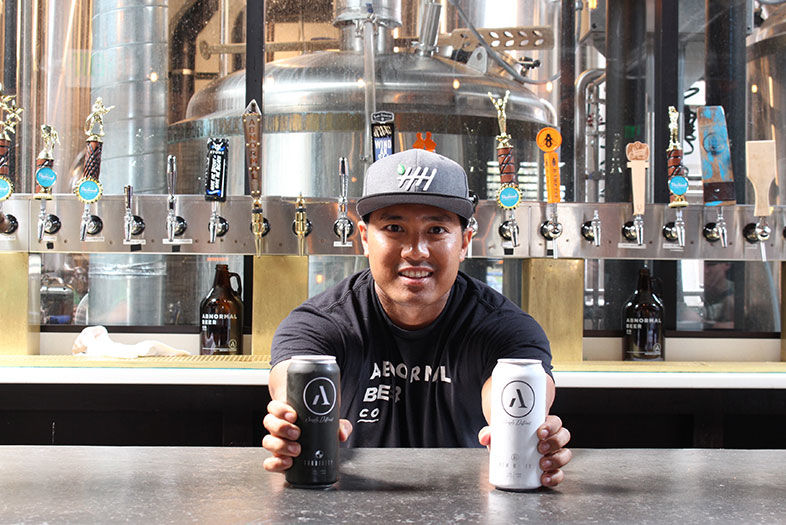
Have a Beer with Abnormal Brewer Derek Gallanosa
PARTNER CONTENT
Abnormal Head Brewer Derek Gallanosa | Photo: Bruce Glassman
